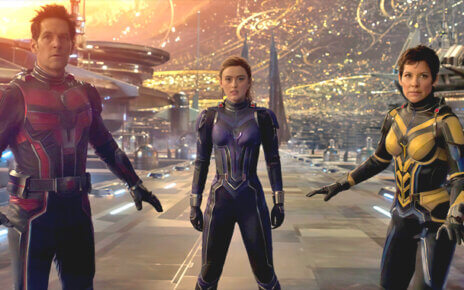The American Dream can mean a lot of different things, but to Jordan Belfort, the titular “wolf” in “The Wolf of Wall Street,” it’s quite simple: Getting rich and living large. But how far can one push the American Dream before it becomes a nightmare?
This is what director Martin Scorsese explores in his latest opus, “The Wolf of Wall Street,” a stylish, fast-paced, and completely unforgettable romp through the greatest and most ridiculous excesses to come out of Wall Street that speeds through its three-hour run time in a pristine Lamborghini.
Set in the late 80’s and early 90’s, when everyone seemed to want a bite of Wall-Street’s cheddar, “The Wolf of Wall Street” tells the true story of Jordan Belfort (Leonardo DiCaprio), a stock broker who started his own firm called Stratton Oakmont with a bunch of scoundrels in Long Island, employed some more than shady business practices, and yes, got insanely, deliriously rich in the process.
It’s sort of a rags-to-riches story, as Belfort’s humble beginnings and naïve attitude in the film’s beginning greatly contrast the ruthless, hedonistic monster he’d grow into, but “riches” feels like an understatement. In fact, what “The Wolf of Wall Street” does best is highlight just how rich he is, from the enormous pool parties to yachts with helicopters attached to all of the drugs and women in the world, to really paint the portrait of a man on top of the world. But wait, how does that old adage go? Oh yeah, what goes up….
“The Wolf of Wall Street” is without a doubt a Scorsese character piece, and while it’s uncertain whether or not Belfort will join the ranks of Travis Bickle and Jake LaMotta, DiCaprio still does an excellent job of bringing the character to life. His slick black hair, fine suits, and terrible tan definitely help him look the part, but the wolf really comes to life in his performance, whether he pursues money-making like a blood-thirsty warrior as he riles up his army of employees or hilariously crawling on the floor after popping too many Quaaludes.
At his right hand throughout the film is Donnie Azoff (Jonah Hill), who although is much less developed as a character than Belfort, is no less memorable. With his tortoise shell glasses, obvious platinum veneers, grating Long Island accent, Donnie is as annoying and desperate a leech as they come, and Hill plays the role to the T as he frequently loses his cool in spectacular fashion and effortlessly spouts out memorable dialogue like they were punctuation marks.
“Wolf” is Belfort’s show for the most part, but it wouldn’t be a Scorsese film without a fair share of memorable characters peppered throughout. Naomi “The Duchess of Bay Ridge” Lapaglia (Margot Robbie), for instance, seems at first like she’s only there to look pretty as Belfort’s fantasy woman and eventual wife. However, Robbie finds her inner Mona Lisa Vito while arguing with Belfort, using tons of Brooklyn venom and sass to put the Wolf in his place. Also memorable, though highly underutilized, is Rob Reiner as Belfort’s father, “Mad Max” Belfort, whose rage-induced swear-a-thons never ceased to be amusing.
Every one of Scorsese’s films feels unique in their own right, and “The Wolf of Wall Street” is no different. That being said, it’s nearly impossible to watch the film without having flashbacks to one of Scorsese’s most memorable films, “Goodfellas” (1991). At times, the comparisons might seem too detrimental, as the story follows an incredibly similar arc, focuses largely on crime (though not on Mafia crime), and utilizes narration and occasional fourth wall breaking to tell the story. And though DiCaprio’s narration is full of color and enthusiasm, his voice does sound eerily familiar to Ray Liotta’s in “Goodfellas”.
But considering the lavish, excessive nature of Belfort’s world, “Goodfellas” feels like the perfect reference point to tell his story. Like “Goodfellas”, “The Wolf of Wall Street” starts at lightning pace and never lets up, using quick cuts and transitions, incredibly inventive cinematography, and scenes that are just flat-out ridiculous. Seriously, the very first scene is of a group of wild, cheering stockbrokers tossing a little person into a bullseye.
Also, like “Goodfellas” did beforehand, Wolf does an excellent job of fleshing out the world 1980’s Wall Street through its characters and set design. The chaotic offices of Stratton Oakmont are adorned with the blocky computers, fax machines, and corded phones of the era, and many characters, from Donnie’s laughable pastel shirts to Belfort’s first wife Teresa’s (Cristin Milioti) large hairdo, look the part without descending into parody.
The only disappointment in this aspect of setting the scene was the soundtrack, which included almost no 80’s songs. “Goodfellas” had an expertly crafted soundtrack that captured the film’s changing time periods, but in Wolf, we get the incredibly out of place Foo Fighters and a pop punk cover The Beach Boys? Come on, Scorsese; where’s the Huey Lewis!
One thing that Scorsese refuses to skimp on, however, is the debauchery, as “The Wolf of Wall Street” might be his most excessive movie to date. “Goodfellas” was a pretty raunchy movie in its own right, but by today’s standards, its child’s play compared to the amount of sex, drugs, and partying depicted throughout Wolf’s three-hour span. And though Scorsese’s flicks are notorious for their use of profanity, Wolf sets a new record for use of the “F” word (literally, it has at 569 uses. Look it up).
Though a large threshold for such language and racy activity is required, very little of what happens feels overly gratuitous or needless. Wall Street in the 80’s was known for being absolutely excessive and even irresponsible in the way people approached wealth and greed, and the way Belfort and the employees of Stratton Oakmont indulge so haphazardly perfectly drives this point home. Sure it’s amusing to see Belfort and Donnie completely zonked out for half the movie, but their inability to compose themselves and dependency on getting high just becomes pathetic. If this is the American Dream, then it ultimately comes off as cheap and rather bleak.
“The Wolf of Wall Street” is not only a brilliant examination ultimate trappings of greed and excess in 1980’s New York, but an engaging, hilarious, and exciting film that deeply fleshes out not only its main character, but the world surrounding him as well. It’s an incredibly fun movie; just don’t try to have as much fun as the characters on the screen.
PHOTO TAKEN from dealflicks.com



